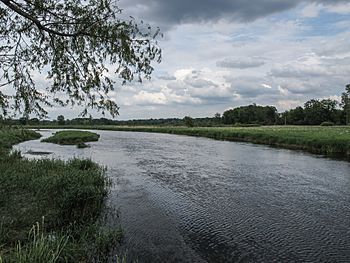Fawn River (Michigan) facts for kids
Quick facts for kids Fawn River |
|
|---|---|

The Fawn River in Florence Township, Michigan
|
|
| Country | United States |
| Physical characteristics | |
| Main source | Steuben County north of Orland, Indiana 939 ft (286 m) 41°44′19″N 85°10′01″W / 41.7386111°N 85.1669444°W |
| River mouth | Confluence with the St. Joseph River at Constantine, Michigan 774 ft (236 m) 41°50′45″N 85°40′02″W / 41.8458333°N 85.6672222°W |
| Length | 55 mi (89 km) |
| Basin features | |
| Progression | Fawn River → St. Joseph River → Lake Michigan → Great Lakes → St. Lawrence River → Gulf of St. Lawrence |
| GNIS ID | 452598 |
The Fawn River is a cool river, about 55 miles (89 kilometers) long, that flows through parts of Indiana and Michigan in the United States. It's like a watery highway that eventually joins up with the St. Joseph River in the town of Constantine, Michigan.
The Fawn River starts its journey in northern Steuben County, Indiana, near Pokagon State Park. Here, it's sometimes called "Crooked Creek" or "Little Fawn River." It winds its way west and northwest through different counties. It crosses the state line between Indiana and Michigan several times.
The river passes near smaller towns like Fremont, Indiana, Orland, Indiana, Sturgis, Michigan, Howe, Indiana, and White Pigeon, Michigan. The area around the river is mostly rural, meaning it has lots of farms and natural spaces rather than big cities. The Michigan town of Fawn River Township, Michigan is even named after this river!
Where Does the Water Come From?
The Fawn River and all the smaller streams and lakes that flow into it make up its drainage basin. Think of a drainage basin as a giant funnel. All the rain and snow that fall within this area eventually flow into the Fawn River.
The Fawn River's drainage basin covers parts of several counties:
- In Indiana:
- In Michigan:
This means that water from these areas helps to fill the Fawn River as it travels towards the St. Joseph River.
What Are Tributaries?
A tributary is a smaller stream or river that flows into a larger river. The Fawn River has many tributaries, including smaller creeks and the outflow from various lakes. These smaller waterways add water to the Fawn River, making it bigger as it flows along.
Some of the lakes that connect to the Fawn River include:
- Klinger Lake
- Pickerel Lake
- Cedar Lake
- Lee Lake
- Long Noble Lake
- Lime Lake
- Tamarack Lake
- Lake Gage
- Crooked Lake
- Lake James
- Snow Lake
- Lake George
All these lakes and streams help to feed the Fawn River, making it an important part of the local water system.

